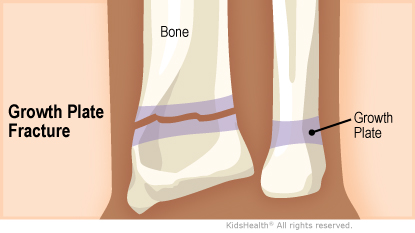- Home
- Humana Medicaid
- Kentucky Medicaid
- Medicaid extras
- Health and wellness
- Parents Home
- Para Padres
- A to Z Dictionary
- Allergy Center
- Asthma
- Cancer
- Diabetes
- Diseases & Conditions
- Doctors & Hospitals
- Emotions & Behavior
- First Aid & Safety
- Flu (Influenza)
- Food Allergies
- General Health
- Growth & Development
- Heart Health & Conditions
- Homework Help Center
- Infections
- Newborn Care
- Nutrition & Fitness
- Play & Learn
- Pregnancy Center
- Preventing Premature Birth
- Q&A
- School & Family Life
- Sports Medicine
- Teens Home
- Para Adolescentes
- Asthma
- Be Your Best Self
- Body & Skin Care
- Cancer
- Diabetes
- Diseases & Conditions
- Drugs & Alcohol
- Flu (Influenza)
- Homework Help
- Infections
- Managing Your Weight
- Medical Care 101
- Mental Health
- Nutrition & Fitness
- Q&A
- Safety & First Aid
- School, Jobs, & Friends
- Sexual Health
- Sports Medicine
- Stress & Coping
Growth Plates
What Is a Growth Plate?
Growth plates are the areas of new bone growth in children and teens. They're made up of , a rubbery, flexible material (the nose, for instance, is made of cartilage).
Most growth plates are near the ends of long bones. Long bones are bones that are longer than they are wide. They include:
- the femur (thighbone)
- the lower legs (tibia and fibula)
- the forearm (radius and ulna)
- the bones in the hands and feet
What Does A Growth Plate Do?
Growth plates are one way bones grow. There are usually two growth plates in each long bone. They add length and width to the bone.
As kids grow, the growth plates harden into solid bone. A growth plate that has completely hardened into solid bone is a closed growth plate. After a growth plate closes, the bones are no longer growing.
When Do Growth Plates Close?
Growth plates usually close near the end of puberty. For girls, this usually is when they're 13–15; for boys, it's when they're 15–17.
What Problems Can Happen With a Growth Plate?
The growth plate is weaker than solid bone. This makes it more likely to get injured.
These problems can happen with growth plates:
Growth Plate Fractures
Growth plate fractures are when there is a break in the growth plate. This happens most often in the bones of the fingers, forearm, and lower leg. Most growth plate fractures heal and do not affect future bone growth.

Sometimes, changes in the growth plate from the fracture can cause problems later. For example, the bone could end up a little crooked or a bit longer or shorter than expected.
Overuse/Repetitive Stress Injuries
Overuse injuries (also called repetitive stress injuries) can affect the growth plate in kids and teens. Overuse injuries happens from repeating the same movement over and over. They usually happen to people who play sports.
Overuse injuries that involve the growth plate include:
- Sever's disease
- Osgood-Schlatter disease
- jumper's knee
- Little League elbow
- Little League shoulder

© 1995- The Nemours Foundation. KidsHealth® is a registered trademark of The Nemours Foundation. All rights reserved.
Images sourced by The Nemours Foundation and Getty Images.